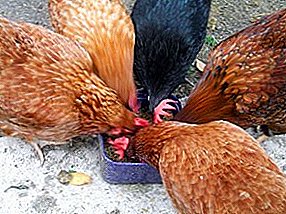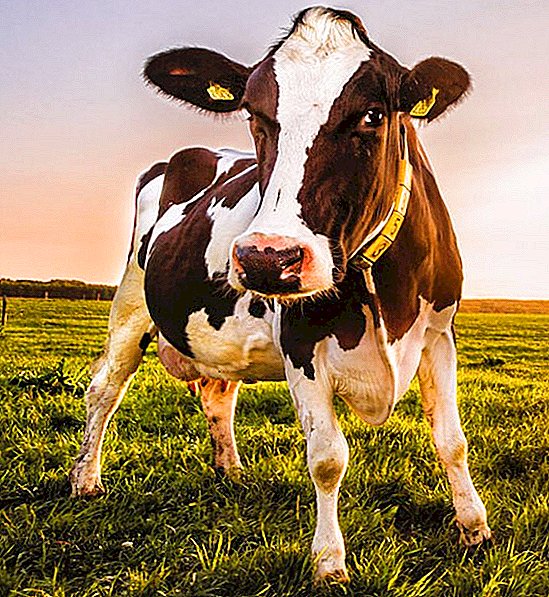 When breeding cattle, each farmer is faced with certain diseases of these animals. Some are quickly treated and soon pass, while others require a more thorough approach to solving the problem. Chlamydia can also be attributed to the latter group, the manifestations of which will depend on the specific form of the disease.
When breeding cattle, each farmer is faced with certain diseases of these animals. Some are quickly treated and soon pass, while others require a more thorough approach to solving the problem. Chlamydia can also be attributed to the latter group, the manifestations of which will depend on the specific form of the disease.
Let's find out what the disease is, what symptoms are characterized and how it is eliminated.
What is this disease
Chlamydia in cattle is a contagious disease of infectious origin, which in young cows is characterized by frequent rhinitis, gastroenteritis, polyarthritis, conjunctivitis, and sometimes pneumonia combined with bronchitis. In addition, it is possible the birth of non-viable individuals and the appearance of mastitis in the cow itself.  This ailment is fixed in almost all countries of the world, and in some even today it causes significant economic damage.
This ailment is fixed in almost all countries of the world, and in some even today it causes significant economic damage.
Important! A person, like animals, can have chlamydia, but this does not mean that you can get infected from your cow. The fact is that in humans and animals the pathogens are different, therefore infection is unlikely (at home, with very close contact with a sick cat, conjunctival chlamydia is possible, but it is very quickly treated and does not cause serious consequences).
Pathogen, sources and routes of infection
The causative agent of the described disease in cattle belongs to the genus Chlamidia, which includes four closely related species: Chl.psittaci, Chl.pecorum, Chl.trachomatis and Chl.pneumoniae. All of them are obligate intracellular parasites that are somewhere in the middle between classic bacteria, rickettsiae and viruses.
They have their own DNA and RNA, which distinguishes these pests from the rest, the so-called "true viruses."
Chlamydia form - spherical or oval. They are able to exist as reticular bodies (that is, intracellularly), not exceeding the diameter of 1.2 microns and having the structure of standard gram-negative bacteria, and can resemble intermediate bodies with a diameter of 0.3-0.4 microns, as in large viruses.  Many varieties of chlamydia have a fairly high resistance to environmental conditions and remain viable at low temperatures, although they are more sensitive to an increase in these values.
Many varieties of chlamydia have a fairly high resistance to environmental conditions and remain viable at low temperatures, although they are more sensitive to an increase in these values.
In a liquid aqueous medium, their activity is maintained for 17 days, and in unpasteurized milk and even longer - as much as 23 days. Being in a lyophilized state, the causative agents of chlamydia calmly exist for up to three years.
The usual concentrations of decontaminating agents for surface treatment (for example, phenol 3% or sodium hydroxide 2%) will help to get rid of them, and tetracycline antibiotics can be used to treat illness in animals or humans.
Anaplasmosis, actinomycosis, parainfluenza-3, pasteurellosis, abscess, and leukemia are also referred to infectious diseases of cattle.
There are several sources of chlamydia:
- sick and recently recovered animals (sometimes they are carriers of the disease for 8 months after healing and transmit the infection along with their secretions);
- abortion from a sick animal;
- milk;
- care items for animals that have recently been in contact with sick individuals (rarely);
- food and common feeder.
 Simply put, infection of healthy cows can occur sexually (the virus is often transmitted along with the sperm of a sick bull), alimentary and aerogenic pathways.
Simply put, infection of healthy cows can occur sexually (the virus is often transmitted along with the sperm of a sick bull), alimentary and aerogenic pathways.Did you know? Cows are characterized by an excellent sense of smell and can catch familiar smells at a distance of more than 5 km.
Forms and symptoms
Symptoms of chlamydia cattle depends on the specific form of the disease. Only five of them and each has its own characteristics of the course and manifestations, but the first symptoms are usually noticeable 3-20 days after infection. Consider each form of the disease more closely.
Respiratory
If chlamydia is ingested by airborne droplets, it is likely that the animal will encounter respiratory chlamydia, the main signs of which are high body temperature for several days (often up to + 40-41 ° C) and the appearance of serous effusions that -3 days acquire mucopurulent consistency.
In addition, the disease is often accompanied by coughing, the mucous membrane of the nose swells and becomes hyperemic. Pulse can increase and the breath of the animal can increase, conjunctivitis or swelling of the eyelids can be observed. 
Intestinal
Intestinal chlamydia cattle cow can get along with the infected food, which remained saliva or other discharge of an already diseased individual. As in the previous case, one of the main signs is an increase in the body temperature of an animal to + 40-40.5 ° C, with which diarrhea, depression and refusal of food are often observed.
The oral mucosa is almost always hyperemic, sores and erosion can appear on it.
Genital
The main signs of genital chlamydia are abortion and delay of the afterbirth. Also, the cow can develop endometritis and metritis, there are frequent excursions, and in some cases, infertility.
The causative agent of this form of the disease is usually spread during artificial or natural insemination using infected sperm or a bull carrier of the disease. With intrauterine transmission, born calves will always be weak, if they are born full-term and viable at all.
Did you know? The nose of the cows is similar to a human finger, since there is the same unique pattern on this part of the body as on the pad. It is by its print that animals can be distinguished with an accuracy of up to 100%.
Encephalitis
This form of chlamydia is considered the most serious of all of the above, because it is characterized by lesions of the central nervous system of the animal. Because of this, the movements of the cows can be uncoordinated, and shortly before death, convulsions begin in the cervical and occipital muscles. Head shake possible. 
Conjunctival
Chlamydia of the conjunctival form resembles ordinary conjunctivitis with characteristic tearing. Inflammation of the cornea with its further clouding is possible - keratitis.
Unfortunately, each form of the disease has its own sad statistics:
- With respiratory chlamydia, the incidence is 70-80%, with a fatal outcome at the level of 15-25%.
- The incidence of intestinal form is in the range of 30-70%, with mortality of 20-30%.
- The genital form is characterized by 25-60% morbidity, and death is observed in about 15% of cases.
- Encephalitis chlamydia is much less common than the previous variants, but in this case the mortality of animals is almost 100%.
Important! Sometimes there is a mixed form of chlamydia cattle. That is, for example, signs of the conjunctival form can complement the symptoms of respiratory or intestinal. The treatment regimen does not change much at the same time, since all microorganisms are sensitive to the same drugs.
Laboratory diagnosis
To confirm the diagnosis of chlamydia, at the first appearance of symptoms of pneumonia, enteritis or conjunctivitis (especially with a simultaneous increase in the body temperature of the animal), a veterinarian must be called. He will collect the biomaterial and send samples of secretions and blood for further analysis.  Under laboratory conditions, smears are stained with special reagents and are amenable to several diagnostic tests at once. The most accurate is the serological method, which allows to determine antibodies in the serum and antigens to the disease.
Under laboratory conditions, smears are stained with special reagents and are amenable to several diagnostic tests at once. The most accurate is the serological method, which allows to determine antibodies in the serum and antigens to the disease.
In aborted cows, antibody titers to the group-specific antigen often reach 1: 64-1: 128, which confirms the presence of the disease. The veracity of the results obtained can be guaranteed in 98% of cases.
It is laboratory diagnostics that helps clarify the veterinary assumptions and eliminate the likelihood of leptospirosis, rhinotracheitis, brucellosis, salmonellosis, and other diseases with similar symptoms.
Pathological changes
The acute course of chlamydia can leave imprints on the anatomical structure of the animal, especially aborted calves.
On such fruits can be found:
- swelling of the subcutaneous tissue;
- extensive hemorrhages in the pleura, abdominal mucosa, endocardium and epicardium, as well as in the kidneys and portal lymph nodes;
- hemorrhagic transudant in the abdominal area and sternum;
- fatty dystrophy and liver grit.
- signs of catarrhal abomatitis and enteritis.
 An autopsy of dead cows shows that in all animals the mucous membrane of the nose and larynx is hyperemic, edematous, with multiple hemorrhages.
An autopsy of dead cows shows that in all animals the mucous membrane of the nose and larynx is hyperemic, edematous, with multiple hemorrhages.In the lungs there are foci of compaction, and in the bronchi accumulate mucous or mucopurulent exudate (bronchial lymph nodes of the middle wall can be enlarged in volume and very juicy in the cut).
In the enteral form of the disease (typical for calves of the first days of life), an autopsy reveals the presence of catarrhal gastroenteritis, an inflamed state of the lymph nodes, point hemorrhages. The liver, kidneys and spleen of a calf have dystrophic signs.
In young individuals, and sometimes in adult livestock, proliferative-fibrinous arthritis is often found with increased fluid accumulation in them.
Important! After inspection or at the slightest suspicion of the presence of chlamydia, all aborted or dead animals must be destroyed (better burned), because even after death they are still sources of illness and pose a danger to healthy animals.
How to treat chlamydia in cattle
Chlamydia cattle is treated with antibacterial drugs, however, standard antibiotics and sulfa compounds in this case are ineffective: it is better to pay attention to drugs of the tetracycline group.  Therapy of young individuals is often carried out with oxytetracycline, which is given to calves twice a day, 5,000 units per 1 kg of live weight (a pattern typical of the first day of treatment).
Therapy of young individuals is often carried out with oxytetracycline, which is given to calves twice a day, 5,000 units per 1 kg of live weight (a pattern typical of the first day of treatment).
After that, in the next 9 days, injections are performed with the same preparation, but only once a day. Sometimes sick calves are injected with serum of convalescents, at a dosage of 0.7 ml per 1 kg of live weight. Dibiomycin will be suitable as an auxiliary substance.
Chlamydia pneumonia is best treated with aerosol preparations sprayed on the mucous membrane of diseased cows and calves. The simultaneous use of resistors and immune serums increases the effectiveness of therapy several times.
Treatment for chlamydia in manufacturing bulls follows the same pattern as calves and cows, using the same tetracycline preparations in the above dosages.
Prevention and Vaccination
Chlamydia is not always easy to cure and in some cases it is not possible to avoid the massive death of livestock. Therefore, in order to minimize their losses, it is advisable to carry out timely prevention. The standard method is vaccination using specialized drugs.  The vaccine is injected into the animal once, which guarantees a high level of protection against chlamydia over the next year.
The vaccine is injected into the animal once, which guarantees a high level of protection against chlamydia over the next year.
Important! Vaccination can only be carried out by clinically healthy animals, and when identifying diseased individuals, it is necessary to immediately isolate them from the rest of the population and to begin treatment immediately.
Other preventive measures include:
- ban on grazing of healthy cows in farms with current quarantine (especially with animals from other farms);
- a ban on feeding healthy livestock food residues after feeding already sick individuals;
- regular inspection of all members of the herd with periodic collection of biomaterial (the earlier the disease is detected, the easier it is to prevent the massive death of livestock);
- full disinfection of all rooms, feeding troughs and drinking bowls to which animals have access (carried out according to the terms established by the sanitary services of a specific area);
- a ban on the import and export of animals and their livelihoods outside the farm where chlamydia was detected.
Undoubtedly, chlamydia cattle is the source of many problems, but with the correct approach to the diagnosis and treatment of the disease significant losses can be avoided. When the first suspicious symptoms appear, it is best to consult a veterinarian.












